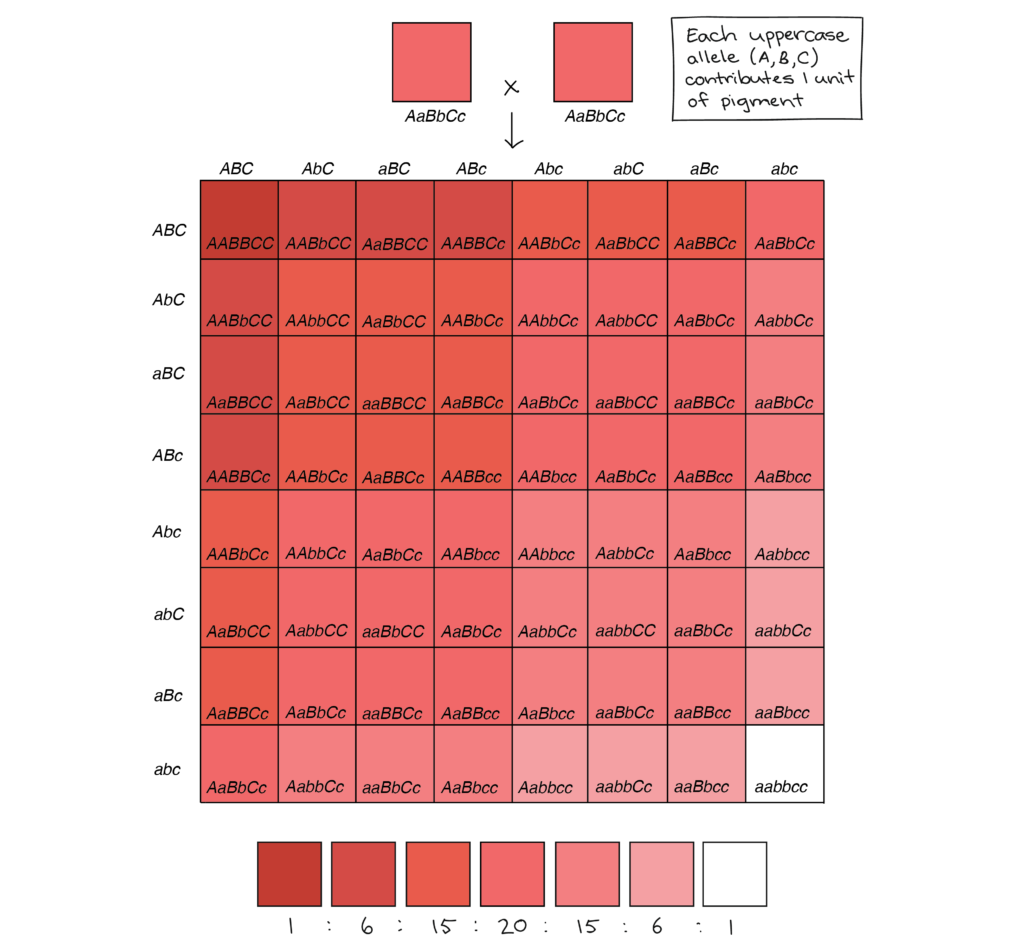Which of the Following Traits Show Continuous Variation
Learning Outcomes
- Describe polygenic inheritance and how to recognize it
- Describe continuous variation and how to recognize it
How is Height Inherited?
Many heritable human characteristics don't seem to follow Mendelian rules in their inheritance patterns. For example, consider human height. Unlike a simple Mendelian characteristic, human height displays:
- Continuous variation. Unlike Mendel's pea plants, humans don't come in two clear-cut "tall" and "short" varieties. In fact, they don't even come in four heights, or eight, or sixteen. Instead, it's possible to get humans of many different heights, and height can vary in increments of inches or fractions of inches. As an example, consider the bell curve-shaped graph in Figure 1, which shows the heights of a group of male high school seniors.
- A complex inheritance pattern. If you've paid attention to the heights of your friends and family, you may have noticed that many different patterns of inheritance are possible. Tall parents can have a short child, short parents can have a tall child, and two parents of different heights may or may not have a child of intermediate height. In addition, siblings with the same two parents may have a range of heights, ones that don't fall into clear, distinct categories. Simple models involving one or two genes can't accurately predict all of these inheritance patterns.
How, then, is height inherited? Height and other similar features are controlled not just by one gene, but rather, by multiple (often many) genes that each make a small contribution to the overall outcome. This inheritance pattern is called polygenic inheritance (poly– = many). For instance, a recent study found over 400 genes linked to variation in height[1]. When there are large numbers of genes involved, it becomes hard to distinguish the effect of each individual gene, and even harder to see that gene variants (alleles) are inherited according to Mendelian rules. In a further complication, height doesn't just depend on genetics: it also depends a lot on environmental factors, such as a child's overall health and the type of nutrition they receive while growing up.
In this article, we'll look in more detail at how complex human traits such as height are inherited, as well as how factors like genetic background and environment can influence the phenotype (observable features) produced by a particular genotype (set of gene variants, or alleles).
Polygenic Inheritance
Some human characteristics, such as height, eye color, and hair color, don't come in just a few distinct forms. Instead, they vary in small gradations, forming a spectrum or continuum of possible phenotypes. Features like these are called quantitative characters, and they're typically controlled by multiple genes (often, many genes), each of which contributes to the overall phenotype. For example, although there are two major eye color genes, there are at least 14 additional genes that play roles in determining a person's exact eye color[2].
Looking at a real example of a human polygenic trait would get complicated, largely because we'd have to keep track of tens, or even hundreds, of different allele pairs. However, we can use an example involving the color of wheat kernels to see how Mendelian inheritance of multiple genes (plus a little incomplete dominance of alleles) can produce a broad spectrum of phenotypes[3]. In this example, there are three genes that make reddish pigment in wheat kernels, which we'll call A, B, and C. Each comes in two alleles, one of which makes a unit of pigment (the capital-letter allele) and one of which does not make any pigment (the lowercase allele). Thus, the aa genotype would contribute zero units of pigment, the Aa genotype would contribute one unit, and the AA genotype would contribute two—basically, a form of incomplete dominance.

Now, let's imagine that two plants heterozygous for all three genes (AaBbCc) were crossed to one another (or, equivalently, allowed to self-fertilize). Each of the parent plants would have three units of pigment, or pinkish kernels. Their offspring, however, could display seven different categories of phenotypes, ranging from zero units of pigment (aabbcc) and pure white kernels to six units of pigment (AABBCC) and dark red kernels, with the intermediate phenotypes being most common.
This example illustrates how we can get a spectrum of slightly different phenotypes (something approaching continuous variation) with just three genes whose alleles display incomplete dominance. It's not hard to imagine that, as we increased the number of genes involved, we'd be able to get even finer variations in color, or in another trait such as height. Real polygenic traits aren't usually quite this clean and simple. (For instance, genes may make unequal contributions to the phenotype, alleles may or may not display incomplete dominance, and there may be non-additive interactions between genes.) However, the basic idea—that multiple genes obeying Mendelian rules can produce a spectrum of finely differing phenotypes—holds true for human traits such as skin and eye color.
PRactice Questions
We've learned about polygenic inheritance and continuous variation. Just what is the difference between these two types of inheritance?
Show Answer
Polygenic traits are traits that rely on multiple genes. Continuous variation describes traits whose phenotypes occur on a continuum, rather than having a limited number of possible phenotypes. Traits with continuous variation are often also polygenic traits, but not always, and not all polygenic traits have continuous variation.
Try It
Contribute!
Did you have an idea for improving this content? We'd love your input.
Improve this pageLearn More
Source: https://courses.lumenlearning.com/wm-biology1/chapter/reading-polygenic-inheritance-and-environmental-effects/
0 Response to "Which of the Following Traits Show Continuous Variation"
Post a Comment